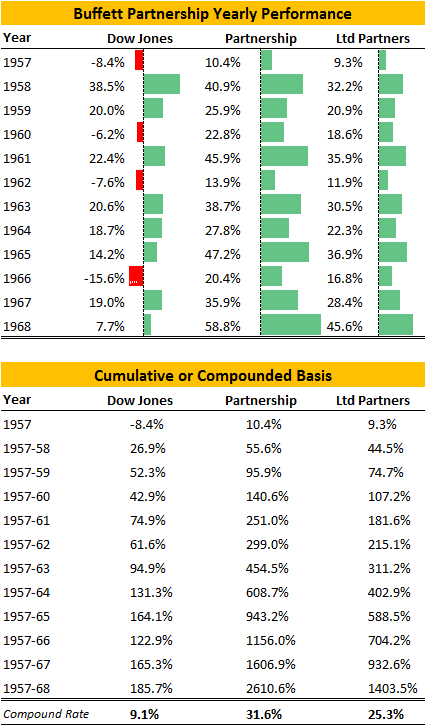Although the current market performance does not reflect the volatility and difficulty in investing in such a market, 2012 so far has been a difficult year.
At the beginning of October, hedge funds were up only a little more than 5% for the year, compared to the total return of 16% for the market.
If the brightest minds as a whole cannot beat the market, then how are small investors like you and me supposed to do any better?
But you know that smaller investors do have advantages over the hedge funds and big institutional investors that solely focus on quarterly performance.
Warren Buffett’s Amazing Strategy that Pounded the Market
One way is by doing what Buffett did during his early partnership days where he pounded the market and every other fund out there, all without putting much risk in his portfolio.
From 1957 to 1968, Buffett achieved annualized returns of 31.6% and I shared with you how this was achieved via Buffett’s secret to such amazing performance.
But I want to highlight one specific strategy he employed specifically for down and volatile markets.
Workouts!
Workouts is another word for special situations such as merger arbitrage, spinoffs, reorganizations etc.
Buffett believed in workouts so much that he invested 23% of his portfolio to these types of investments.
Here is what he had to say about workouts from his 1965 letter:
These are securities with a timetable. They arise from corporate activity – sell outs, mergers, reorganizations, spinoffs etc. In this category we are not talking about rumors or “inside information” pertaining to such developments, but ti publicly announced activities of this sort. We wait until we can read it in the paper. The risk pertains not primarily to general market behavior (although that is sometimes tied in to a degree), but instead to something upsetting the applecart so that the expected development does not materialize. Such killjoys could include anti-trust or other negative government action, stockholder disapproval, withholding of tax rulings, etc.
The gross profits in many workouts appear quite small. It’s a little like looking for parking meters with some time left on them. However, the predictability coupled with a short holding period produces quite decent average annual rates of return after allowance for the occasional substantial loss. This category produces more steady absolute profits from year to year than generals do. In years of market decline it should usually pile up a big edge for us; during bull market it will probably be a drag on performance. On the long term basis, I expect the workouts to achieve the same sort of margin over the Dow attained by generals.
How to Make Use of Workouts Today
If you aren’t sure of where to start or new to workouts and special situations, there are several ways you can participate.
1. Risk Arbitrage
The most common type of special situation where you purchase the stock after news that the company is being bought out. If the merger is seen as highly likely to go through, there may only be a 2% or less spread between the stock price and final buyout price, but if you do this enough, the annualized returns add up, which is what Buffett is referring to.
2. Stock Tenders
A stock tender is when a company announces that it will be buying back a certain number of shares at either a specified price or in the form of a Dutch auction.
The purpose of a tender offer could be to reduce the number of stockholders of record and reduce or eliminate future servicing fees, SEC reporting costs and stock listing fees. Especially when it concerns smaller companies, having a large base of tiny stockholders can certainly eat away profits with administrative tasks.
3. Spinoffs
Spinoffs can take many forms but a simple definition can be defined as a corporation taking one of its subsidiary or business division and then separating it to create a new company. A spinoff usually occurs because the company wants the public to fully recognize the underlying assets of the division and to get a better valuation of the whole company. The newly created company is then valued by the market independently.
Take a look at how Expedia (EXPE) has performed since being spun out of Microsoft, then from InteractiveCorp (IAC) and now after spinning off TripAdvisor (TRIP).
It’s hidden value and earnings power was unlocked and the stock price followed.
4. Going Private Transactions
This is similar to a stock tender, except management decides to take the company private and delist the company. This workout exists mainly for small companies and big profit is not involved, but provided management is able to finance the deal and you have a low-cost brokerage account, you can find a few per year.
Use this advanced SEC search technique to find such opportunities.
5. Arbitrage Event Driven Mutual Fund
If all the above is just too much, then there is a mutual fund dedicated to workouts.
The mutual fund ticker is AEDFX but the expense is high at 1.7% with a portfolio turnover of 490%. More Information and More Competition
One important thing to remember is that news comes faster than 1965.
I’ve had a couple of mergers come undone before news was even released. Keep your positions tight and disciplined, and employing workouts to make up a small part of your portfolio can help stabilize your portfolio when the rest of the market is zigging and zagging.
Don’t forget the other special situation of just waiting and reading. Being able to do this is special in itself.
Disclosure: Jae is the founder of Old School Value and has a mission to empower every investor by providing tools, tutorials and education so that they can invest successfully on their own.
- English (UK)
- English (India)
- English (Canada)
- English (Australia)
- English (South Africa)
- English (Philippines)
- English (Nigeria)
- Deutsch
- Español (España)
- Español (México)
- Français
- Italiano
- Nederlands
- Português (Portugal)
- Polski
- Português (Brasil)
- Русский
- Türkçe
- العربية
- Ελληνικά
- Svenska
- Suomi
- עברית
- 日本語
- 한국어
- 简体中文
- 繁體中文
- Bahasa Indonesia
- Bahasa Melayu
- ไทย
- Tiếng Việt
- हिंदी
How Buffett Made Money In Bad And Volatile Markets
Published 11/02/2012, 03:51 AM
Updated 07/09/2023, 06:31 AM
How Buffett Made Money In Bad And Volatile Markets
3rd party Ad. Not an offer or recommendation by Investing.com. See disclosure here or
remove ads
.
Latest comments
Install Our App
Risk Disclosure: Trading in financial instruments and/or cryptocurrencies involves high risks including the risk of losing some, or all, of your investment amount, and may not be suitable for all investors. Prices of cryptocurrencies are extremely volatile and may be affected by external factors such as financial, regulatory or political events. Trading on margin increases the financial risks.
Before deciding to trade in financial instrument or cryptocurrencies you should be fully informed of the risks and costs associated with trading the financial markets, carefully consider your investment objectives, level of experience, and risk appetite, and seek professional advice where needed.
Fusion Media would like to remind you that the data contained in this website is not necessarily real-time nor accurate. The data and prices on the website are not necessarily provided by any market or exchange, but may be provided by market makers, and so prices may not be accurate and may differ from the actual price at any given market, meaning prices are indicative and not appropriate for trading purposes. Fusion Media and any provider of the data contained in this website will not accept liability for any loss or damage as a result of your trading, or your reliance on the information contained within this website.
It is prohibited to use, store, reproduce, display, modify, transmit or distribute the data contained in this website without the explicit prior written permission of Fusion Media and/or the data provider. All intellectual property rights are reserved by the providers and/or the exchange providing the data contained in this website.
Fusion Media may be compensated by the advertisers that appear on the website, based on your interaction with the advertisements or advertisers.
Before deciding to trade in financial instrument or cryptocurrencies you should be fully informed of the risks and costs associated with trading the financial markets, carefully consider your investment objectives, level of experience, and risk appetite, and seek professional advice where needed.
Fusion Media would like to remind you that the data contained in this website is not necessarily real-time nor accurate. The data and prices on the website are not necessarily provided by any market or exchange, but may be provided by market makers, and so prices may not be accurate and may differ from the actual price at any given market, meaning prices are indicative and not appropriate for trading purposes. Fusion Media and any provider of the data contained in this website will not accept liability for any loss or damage as a result of your trading, or your reliance on the information contained within this website.
It is prohibited to use, store, reproduce, display, modify, transmit or distribute the data contained in this website without the explicit prior written permission of Fusion Media and/or the data provider. All intellectual property rights are reserved by the providers and/or the exchange providing the data contained in this website.
Fusion Media may be compensated by the advertisers that appear on the website, based on your interaction with the advertisements or advertisers.
© 2007-2024 - Fusion Media Limited. All Rights Reserved.
